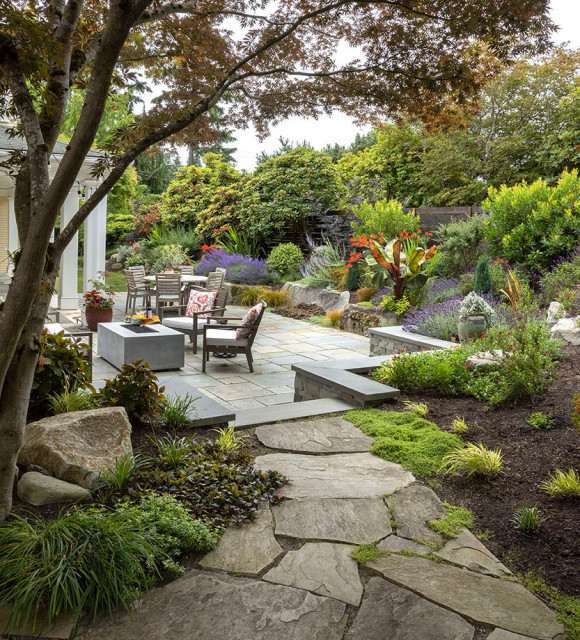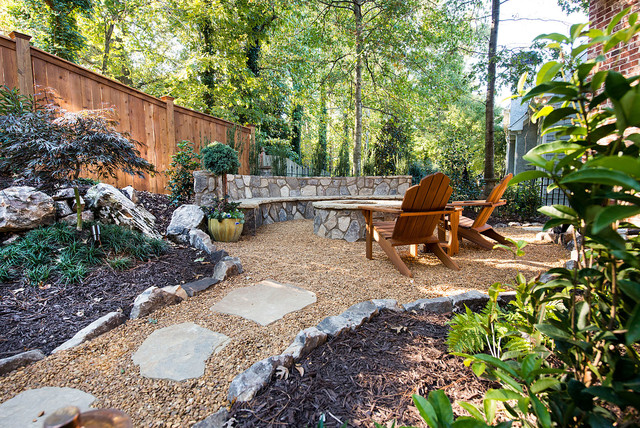Landscape Renovation With a Master Plan
A successful landscape design starts with a detailed and well-thought-out plan. While it can be tempting to dive right in to your renovation, investing the time and budget upfront to map out your entire space will help ensure a cohesive, long-lasting design — and often save time and money in the process. Read on to learn from professionals on Houzz about the details of a landscape master plan, the benefits of getting one and other considerations to make sure you get the landscape you want.
What Is a Landscape Master Plan?
A landscape master plan, also called a site plan, is a detailed scaled drawing that shows everything in a landscape’s overall design. It includes the site’s orientation and conditions, from sun and wind patterns to soil, drainage and slope issues. The plan also contains the design’s hardscape and structural elements — with specified materials for each — along with the planting plan and house location.

The Benefits of Having a Landscape Master Plan
A master plan gives you both a starting point and blueprint for later decisions.
A master plan has practical implementations beyond determining your landscape’s future design. “It usually keeps you from having to redo work,” True says, as you’re able to map out a logical design and construction schedule. You can also budget for expenses both now and in the future. Depending on the scope of work, a master plan may also be required to obtain permits.
A master plan gives you both a starting point and blueprint for later decisions.
A master plan has practical implementations beyond determining your landscape’s future design. “It usually keeps you from having to redo work,” True says, as you’re able to map out a logical design and construction schedule. You can also budget for expenses both now and in the future. Depending on the scope of work, a master plan may also be required to obtain permits.
Who Creates It?
Both landscape architects and landscape designers can create a detailed master plan for your space. A landscape architect is trained and licensed to provide plans for all aspects of landscape design. You may be required to use their services for projects that include grading, drainage, retaining walls or other structural elements.
Landscape designers are not licensed, although they may have similar or the same training as a landscape architect. They also might specialize in plant choices as well as design.
While landscape contractors focus on the landscape’s building and installation, many can also help you with design decisions. They may have a designer on staff or be able to provide recommendations for landscape architects and designers that would be a good match for you.
How Much Does One Cost?
Costs for a master plan vary greatly, depending on your location, the pro’s expertise and the project’s complexity. A relatively simple design may be several hundred dollars. A full-scale landscape design can cost well over $1,000.
Start With a Landscape Design Consultation
Once you’ve found a pro you think you’d like to work with, schedule a landscape design consultation. This gives both you and the pro the chance to meet, review your yard’s current conditions and decide if you want to move forward on the project together.
Before you meet, think about what you want for your finished landscape. Include both practical considerations and features you would love to include if possible.
Also share what your current budget is. You don’t need a specific dollar amount, but knowing a realistic range allows the pro to share ideas and proposals that are possible within your budget.
Pro tip: Ideally, everyone who will decide on the final design should attend the first meeting. The pros will be able to hear from all those making decisions and everyone will be able to see if the fit seems right.
The Planning Process
After the parties choose to move forward on the project, the designer then puts ideas to paper. This “first look,” which will include preliminary details of the final design, is the chance for everyone to weigh in on what they like as well as what isn’t working.
Take this time to study the plan, ask questions and make changes. Be sure you understand the different elements showcased. Feel free to ask about even minor details such as patio size, walkway width or how the plants will look now versus when they mature.
The revision process may take some time until everyone is satisfied, so don’t be discouraged if it feels like things aren’t moving forward.
Next Steps
When your plan is finalized, it’s time to turn it into reality.
Decide if you want to do the project all at once or in phases. This may be driven by your schedule, budget or personal preference.
If you’re looking at a phased landscape project, a good starting point is to add any planned trees or large ornamental shrubs that won’t be affected by future work. They’ll have time to mature while you’re waiting on the rest of the installation. Other projects to tackle early on might include solving drainage issues, adding retaining walls or installing a path, patio or deck.
Above all, don’t consider your master plan etched in stone. Landscapes are, by their very nature, always changing as plants grow and fill in. The same is true of outside factors that affect your space. A once-sunny spot may become a shady retreat as trees mature or structures are added around you.
Your wish list may also change. A play area may become a vegetable garden rather than a pool. Your entertaining area may become larger than expected or your front yard may evolve from a plant-filled space into a welcoming front courtyard where you can interact with your neighbors. A well-designed master plan will let you adapt to these changes while still respecting the overall look and feel of your landscape.









Comments
Post a Comment